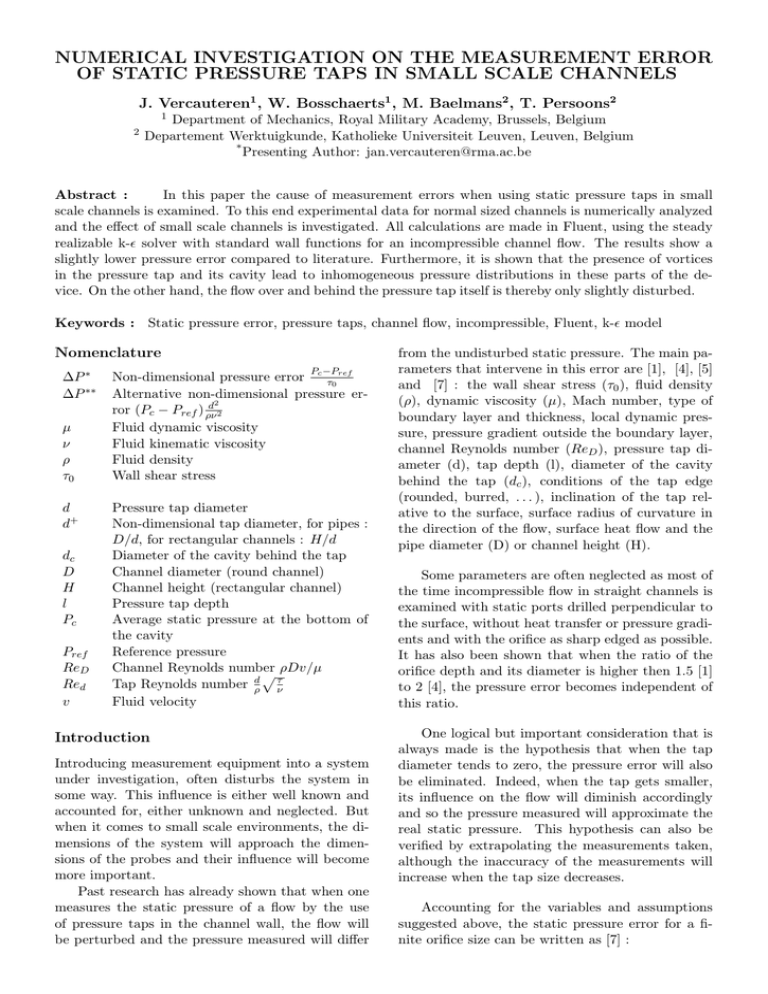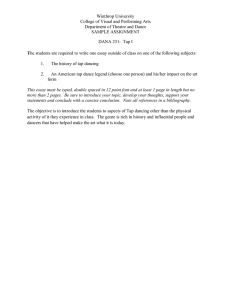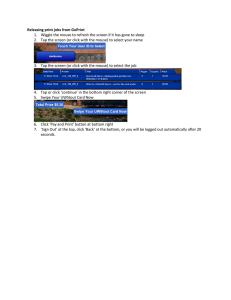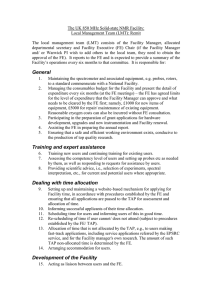NUMERICAL INVESTIGATION ON THE MEASUREMENT ERROR J. Vercauteren , W. Bosschaerts
advertisement

NUMERICAL INVESTIGATION ON THE MEASUREMENT ERROR OF STATIC PRESSURE TAPS IN SMALL SCALE CHANNELS J. Vercauteren1 , W. Bosschaerts1 , M. Baelmans2 , T. Persoons2 1 2 Department of Mechanics, Royal Military Academy, Brussels, Belgium Departement Werktuigkunde, Katholieke Universiteit Leuven, Leuven, Belgium * Presenting Author: jan.vercauteren@rma.ac.be Abstract : In this paper the cause of measurement errors when using static pressure taps in small scale channels is examined. To this end experimental data for normal sized channels is numerically analyzed and the effect of small scale channels is investigated. All calculations are made in Fluent, using the steady realizable k- solver with standard wall functions for an incompressible channel flow. The results show a slightly lower pressure error compared to literature. Furthermore, it is shown that the presence of vortices in the pressure tap and its cavity lead to inhomogeneous pressure distributions in these parts of the device. On the other hand, the flow over and behind the pressure tap itself is thereby only slightly disturbed. Keywords : Static pressure error, pressure taps, channel flow, incompressible, Fluent, k- model Nomenclature ∆P ∗ ∆P ∗∗ µ ν ρ τ0 d d+ dc D H l Pc Pref ReD Red v P −P Non-dimensional pressure error c τ0 ref Alternative non-dimensional pressure erd2 ror (Pc − Pref ) ρν 2 Fluid dynamic viscosity Fluid kinematic viscosity Fluid density Wall shear stress Pressure tap diameter Non-dimensional tap diameter, for pipes : D/d, for rectangular channels : H/d Diameter of the cavity behind the tap Channel diameter (round channel) Channel height (rectangular channel) Pressure tap depth Average static pressure at the bottom of the cavity Reference pressure Channel Reynolds number p ρDv/µ Tap Reynolds number dρ ντ Fluid velocity Introduction Introducing measurement equipment into a system under investigation, often disturbs the system in some way. This influence is either well known and accounted for, either unknown and neglected. But when it comes to small scale environments, the dimensions of the system will approach the dimensions of the probes and their influence will become more important. Past research has already shown that when one measures the static pressure of a flow by the use of pressure taps in the channel wall, the flow will be perturbed and the pressure measured will differ from the undisturbed static pressure. The main parameters that intervene in this error are [1], [4], [5] and [7] : the wall shear stress (τ0 ), fluid density (ρ), dynamic viscosity (µ), Mach number, type of boundary layer and thickness, local dynamic pressure, pressure gradient outside the boundary layer, channel Reynolds number (ReD ), pressure tap diameter (d), tap depth (l), diameter of the cavity behind the tap (dc ), conditions of the tap edge (rounded, burred, . . . ), inclination of the tap relative to the surface, surface radius of curvature in the direction of the flow, surface heat flow and the pipe diameter (D) or channel height (H). Some parameters are often neglected as most of the time incompressible flow in straight channels is examined with static ports drilled perpendicular to the surface, without heat transfer or pressure gradients and with the orifice as sharp edged as possible. It has also been shown that when the ratio of the orifice depth and its diameter is higher then 1.5 [1] to 2 [4], the pressure error becomes independent of this ratio. One logical but important consideration that is always made is the hypothesis that when the tap diameter tends to zero, the pressure error will also be eliminated. Indeed, when the tap gets smaller, its influence on the flow will diminish accordingly and so the pressure measured will approximate the real static pressure. This hypothesis can also be verified by extrapolating the measurements taken, although the inaccuracy of the measurements will increase when the tap size decreases. Accounting for the variables and assumptions suggested above, the static pressure error for a finite orifice size can be written as [7] : r P − Pref d τ0 l D dc ∗ ∆P = =F , , , , ReD τ0 ν ρ d d d (1) q We denote Red = νd τρ0 the Reynolds number based on the wall shear stress and the orifice diameter. It has been shown by past researchers that an increase in Red will increase the absolute pressure error ∆P ∗ up to as many as 7 times τ0 for Red higher than 2000. Billington [6] suggested a logarithmic dependence of ∆P ∗ on Red for laminar flow regimes. Other researchers, like Shaw [3], suggested relations like equation (2). ∆P ∗ = a (Red )b (2) Concerning the influence of ReD , early researchers like Rainbird [1], Shaw [4] and Billington [6] found that it had no influence on the pressure error. Only the status of the flow (laminar or turbulent) was of importance. This conclusion was however contested by McKean and Smits [7] who clearly showed that for high values of Red , the pressure error is proportional to ReD . Nevertheless, all researchers agree that there is a noticeable difference between laminar and turbulent flows. Most past research has however been conducted in round shaped pipes or flat plates and few in rectangular ducts and none in annular ones. Also, nothing has been reported on non-developed flows, the influence of the proximity of obstacles to the pressure tap or the effect of high D/d ratios. As this might be the case in small systems, there is certainly a need for further research in this domain. The current research aims at investigating the pressure error induced by the use of a pressure tap in incompressible flow through a rectangular channel, at Red < 1000 and d+ > 0.1. First, numerical calculations were performed as to direct the experimental work that will follow. The results of this preliminary work are presented here. Numerical set-up The numerical calculations are performed with Fluent using the steady realizable k- solver with standard wall functions. This solver is chosen as initial calculations showed that, when compared to the kω and laminar solvers, the results tended more towards the experimental results found in literature. Special attention is given to the behavior of the flow in the pressure tap and the cavity behind it as well as the influence of the non-dimensional tap diameter (d+ ) and the wall shear stress on the pressure error. As little is know about time dependent effects of the pressure tap on the flow or the pressure error, only steady state simulations are carried out as to first verify the model with known experimental data. The set-up is a 50mm high two-dimensional channel trough which a fully developed incompressible flow of air is simulated for bulk velocities varying between 10 and 40m/s, which results in a channel Reynolds number (based on the channel hydraulic diameter) between 791 and 3165. First, the velocity profile of a fully developed flow is calculated by simulating the flow in a straight 30cm long channel and coupling the output flow to the inlet. The simulation is halted when the in- and outlet velocity profile match and when the shear stress at the channel walls is constant. The pressure and wall shear stress 10cm in front of the outlet are then taken as the references for the analysis of the pressure tap results. The pressure taps are simulated as-well in a 30cm long channel with the tap center 10cm from the outlet. The tap radius varies between 1 and 50mm and is twice as deep. The cavity is taken 5 times as wide as the tap diameter and 6 times as deep. Besides Chue [8], who pointed out that a wide cavity reduces the pressure error, very little is written about the influence of the cavity. So at first, this cavity size seems large enough to start with. This will be discussed in the next section. With this set-up, Red should vary between 0 and 1000 with d+ between 5 and 50. It allowed a good comparison of the numerical calculations with literature data as to validate the model. Discussion For each set-up, the average pressure at the bottom of the cavity Pc is calculated, as this would be the pressure measured by experimental means. With this, the non-dimensional pressure error ∆P ∗ is then retrieved. The results are shown in figure 1 and are compared to the experimental results of Shaw [4] who’s results are most often used as a reference. The results from the simulations show an overestimation of the pressure error at lower values of Red while at higher values, the error is estimated too low. It should be noted that, although scatter in the non-dimensional pressure error can be readily reduced by a longer run of simulations, leading to smaller convergence errors, the results of the numerical simulations still exhibit some scatter. This scatter is induced because of the normalization of the pressure error by the shear stress τ0 . Besides the actual pressure error, some interesting phenomena can be noticed. First of all, two counter-rotating vortices are present in the pressure tap and one big vortex in the cavity itself. This had already been reported by McKeon and Smits [7] who attributed it to the flow that is deflected into the tap. Figure 3 shows one example for a 30m/s flow over a 8mm orifice. The upper vortex is clearly stronger and bigger then the second one. The resulting pressure distribution for the same set-up is given in figure 4. Figure 1: Numerical results of ∆P ∗ vs Red for a 50mm two-dimensional channel, compared with Shaw [4] Franklin & Wallace [10] already noticed some scatter in their experimental results, especially for low Red . According to them, the main contributing factor to this is the use of τ0 to make the pressure non-dimensional. They therefore propose an alternative non-dimensional pressure error: ∆P ∗∗ = (Pc − Pref ) d2 ρν 2 (3) Figure 3: Close-up of the vortices generated in a 8mm pressure tap in a 50mm two-dimensional channel and for an airflow of 30m/s (Red = 898) With this new parameter, we also obtain a much better alignment of the results and an even better agreement with literature (Shaw [4]), especially for values of Red above 250, as shown in figure 2. So the slightly lower values of ∆P ∗ in figure 1 may have been caused by an overestimation of τ0 by the model. Figure 4: Static pressure distribution in a 8mm orifice in a 50mm two-dimensional channel and for an airflow of 30m/s (Red = 898) Figure 2: Numerical results of the alternative pressure error ∆P ∗∗ vs Red for a 50mm twodimensional channel, compared with Shaw [4] When comparing our results here with Shaw [4] for Red above 250, we can deduce a power law for ∆P ∗∗ like in equation 2. The parameters for both Shaw and the ones obtained here in this region are : a b −2 Shaw 2.2 10 2.7 Current 8.4 10−2 2.4 Due to the motion of the fluid in the cavity, the pressure distribution on the bottom of it is no longer homogeneous. Although the influence of the cavity has not yet been fully investigated, it is clear that its geometry will contribute to the pressure error. As the second vortex in the pressure tap is already weaker then the first, the cavity vortex will probably loose its strength when the depth of the cavity increases and hence the average pressure at the bottom will increase as well. Most of the time, in experimental investigations, the cavity will be linked to the pressure transducer by some kind of tubing, which will have the same effect. This may also explain the higher pressure error obtained by Shaw when compared with our results. Finally, as already can be noticed in figure 4, the presence of the cavity changes the pressure gradi- ent at the bottom of the channel up to a few tap diameters downstream. This is due to the “pitot effect” of the tap, which had already been reported by Shaw [4]. Behind the tap, the original gradient is rapidly regained. This “blockage” also increases the turbulence above and behind the tap, as is shown in figure 5 which shows a big increase of the turbulence kinetic energy above and at the downwind side of the tap. This disturbance doesn’t extend far in the channel flow and rapidly fades out so the presence of the tap has little effect on the general flow in the channel. Reducing d+ might however amplify the effect. This has yet to be investigated. gradient is increased, due to the “pitot effect” of the tap. Also, the turbulent kinetic energy increases but rapidly fades out further downstream. References [1] Rainbird W.J., Errors in measurement of mean static pressure of a moving fluid due to pressure hole, Quart. Bull., Division of Mechanical Engineering and the national aeronautical establishment (Canada), report No DME/NAE 1967(3) [2] Rainbird W.J., A note on static hole errors., Quartely Bulletin DME/NAE 1964(3), National Research Council, Ont., pp 74-75 [3] Shaw R., The measurement of static pressure, AGARD report no 163, p4, march 1958 [4] Shaw R., The influence of hole dimensions on static pressure measurements, J. Fluid Mech., Vol 7, Part IV, p 550, 1959 Figure 5: Turbulence kinetic energy for a 8mm pressure tap in a 50mm two-dimensional channel and for an airflow of 30m/s (Red = 898) Conclusion The Fluent steady realizable k- solver with the standard wall function slightly overestimates the wall shear stress for our set-up which leads to smaller pressure errors than reported by literature. For this reason, the right solver and boundary layer model is still the main trigger for the ongoing research. Still, the results show the need for an alternative method for making the pressure error nondimensional to eliminate most of the scatter in the results. Secondly, the simulations showed the presence of several vortices in the tap and cavity which clearly have its influence on the results. As little is known about the dependence on the geometry of the cavity, more research is required in this domain. Nevertheless, the lower values of the pressure error could also be caused by the fact that the experimental work from literature was probably obtained with a longer cavity then was used in the simulations here. Finally, the influence of the tap on the flow itself seems to be limited to a small region above and downwind of the tap. Above the tap, the pressure [5] Rayle R.E., Influence of orifice geometry on static pressure measurements, ASME paper 59A-234, dec 1959 [6] Billington I.J., Experimental assessment of the validity of pressure measurements in the fluid film between seal faces, Second International Conference on fluid sealing, The British Hydromechanics Research Association, Cranfield, England, April 1964 [7] McKeon B.J. and Smits A.J., Static pressure correction in high Reynolds number fully developed turbulent pipe flow, Meas. Sci. Technol. 13 (2002) 1608-1614 [8] Chue, Pressure probes for fluid measurements, 1975 Prog. Aerosp. Sci. 16 147 −223 [9] Ray, On the effect of orifice size on static pressure reading at different Reynolds numbers, Ing.-Arch. 24 3 [10] R.E. Franklin and J.M. Wallace, Absolute measurements of static-hole error using flush transducers, J. Fluid MEch., Vol 42, Part I, pp 3348, 1970 [11] Livesey L., Jackson J.D., Southern C.J., The static hole error problem, Aircraft engineering, Vol 34, Bunhill Publications Ltd, London, pp 43-47, 1962


